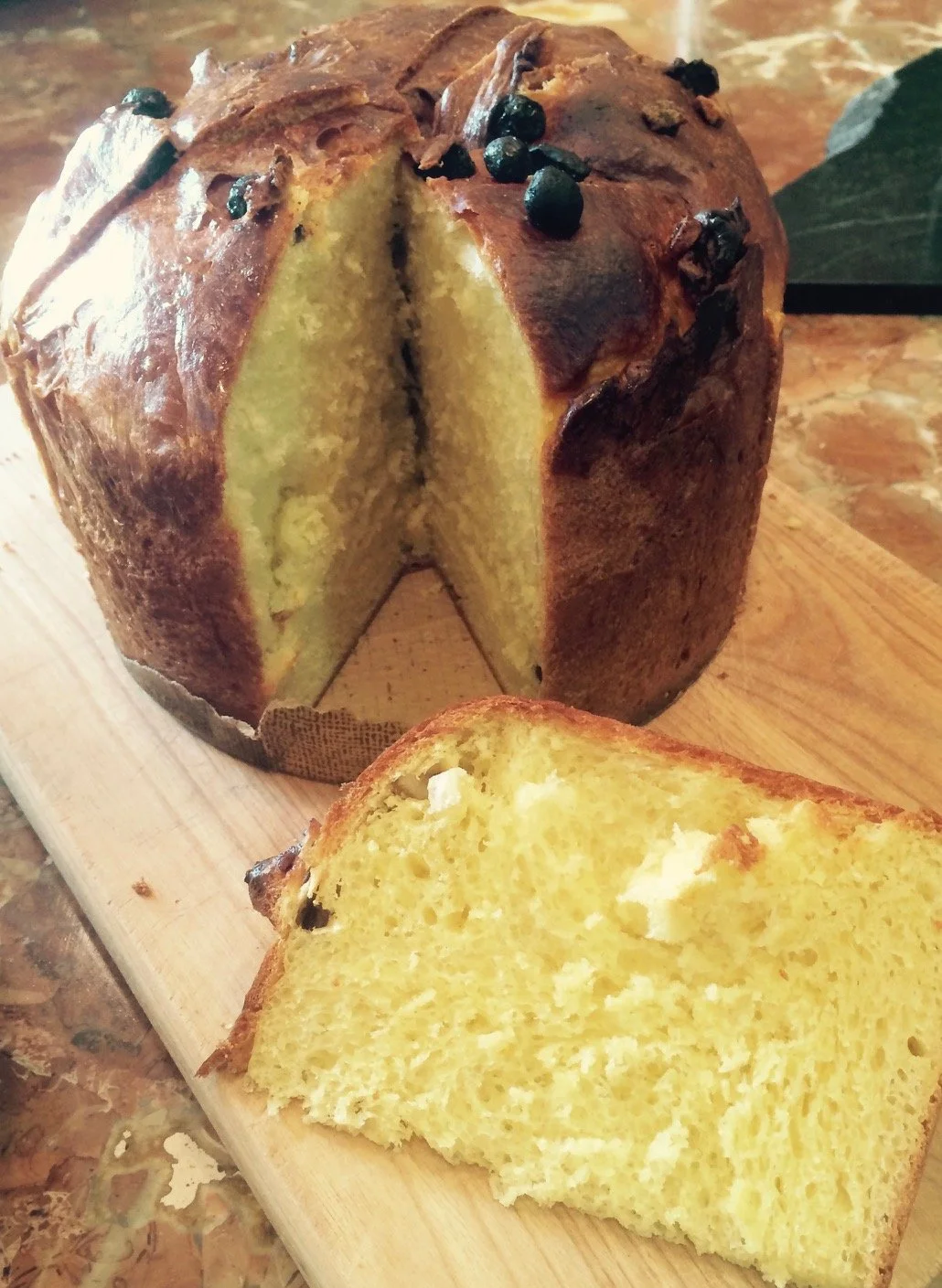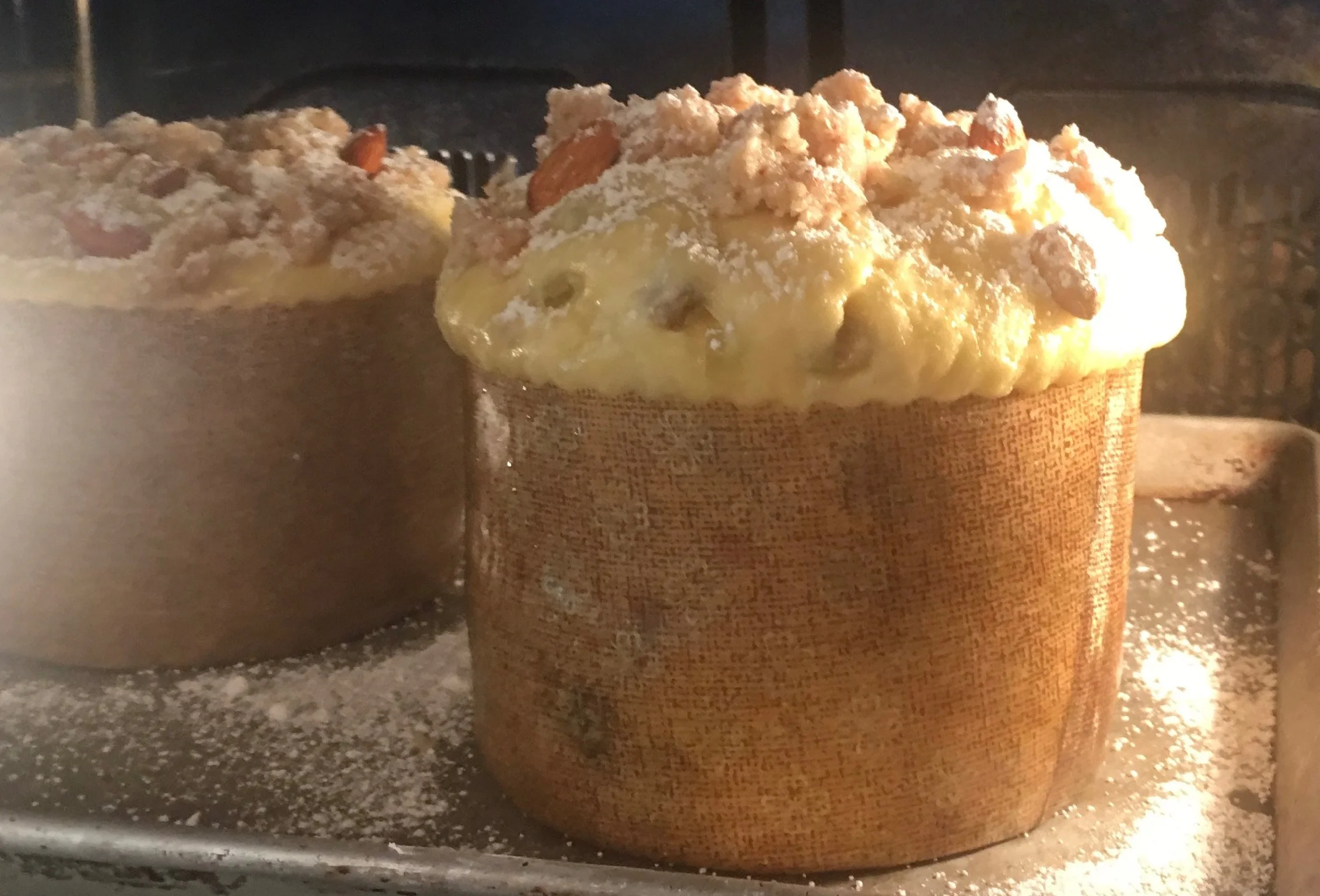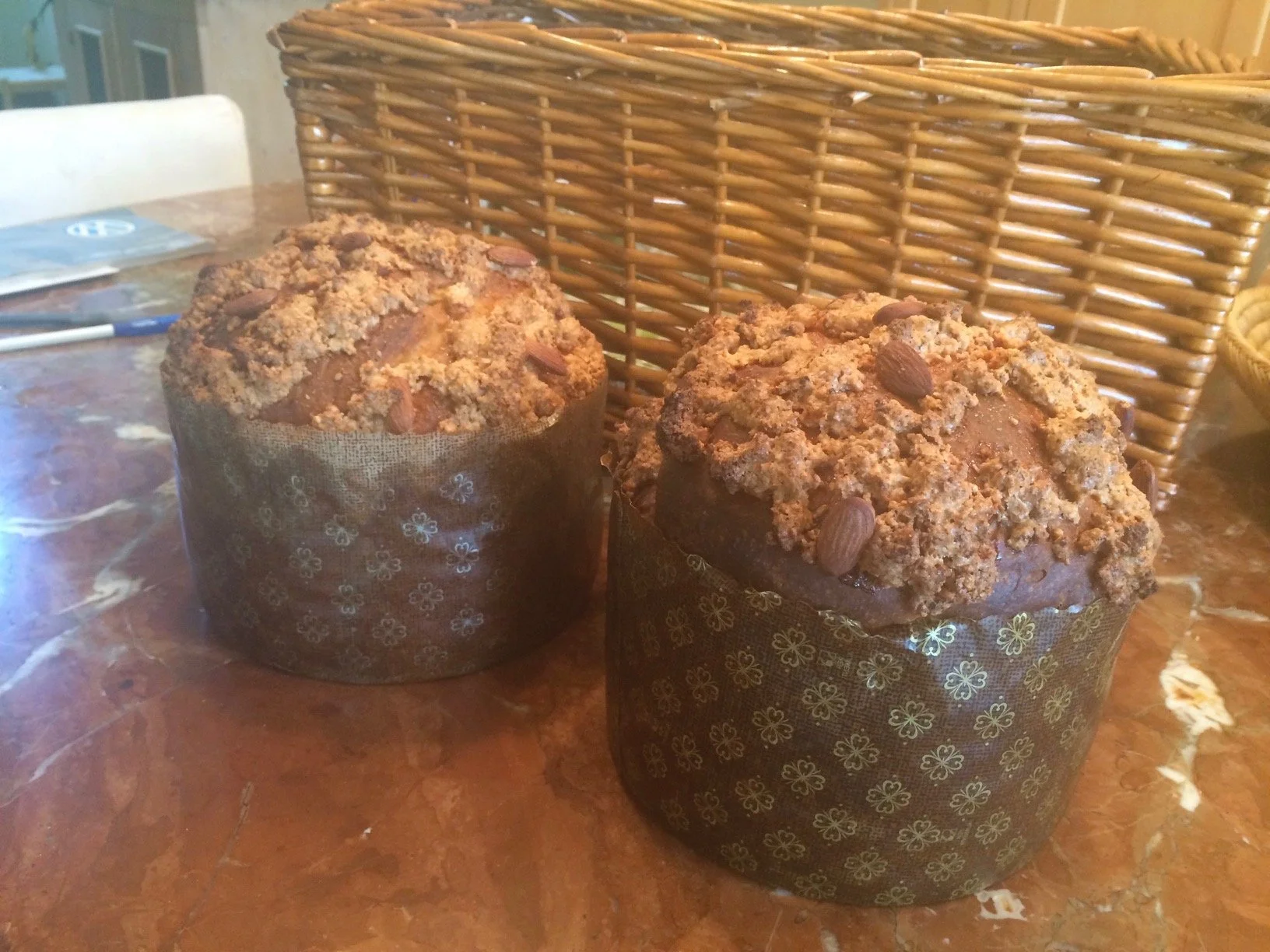Easter Bread
Every Easter I make a rich buttery and decorative yeasted bread to grace the breakfast brunch table. And often the bread has its origin in Italy and more often than not it is pannetone. Now, to be correct, pannetone is traditionally a famous Italian Christmas bread; however, the dough is almost identical to the traditional Easter Bread, Colomba Pasquale except for the quantity of some butter and eggs, the final shaping of the dough and an almond topping. I am sharing the pannetone recipe I use from Carol Field’s book, The Italian Baker, which I have adapted slightly to update it and/or include substitutions. This cookbook holds a special place among the many favorites in my home library for dependable recipes and especially for the representation of original Italian baking recipes. This recipe, as many in the book, is a bit detailed, but worth every moment of the attention you give it. Enjoy.
Pannetone (Makes 2 cylindrical loaves)
Step 1 - Make a Sponge by stirring 2 ½ teaspoons active dry yeast into 1/3 cup warm water. Let stand until it looks creamy, about 10 minutes Stir in ½ cup unbleached all purpose flour. Cover with plastic wrap and let rise in a warm spot for 20-30 minutes. Note: if using instant yeast combine the yeast with the flour first and then add the water, stir well and cover, and let rise.
Step 2 - While the sponge is rising measure out the ingredients for the First Dough:
2 ½ teaspoons active dry yeast or instant yeast.
3 tablespoons warm water
2 large eggs , room temperature
1 ¼ cups unbleached all purpose flour
¼ cup granulated sugar
½ stick unsalted butter, room temperature
When the sponge has risen begin put the First Dough together:
In a mixer bowl measure the water and stir in the yeast. Let stand until creamy about 10 minutes. Add the sponge, eggs, flour and sugar and mix with the paddle. Add the butter and mix until the dough is smooth about 3 minutes. Cover with plastic wrap and let rise until doubled about 1 to 1 ¼ hours.
(If using instant yeast, first measure the sponge, eggs, and sugar into the mixing bowl and mix with the paddle. In a small bowl mix the flour and yeast together then add to the wet mixture in the mixing bowl and combine well with the paddle. Add the butter and mix until the dough is smooth about 3 minutes.) Cover with plastic wrap and let rise until doubled about 1-1 ¼ hours.**
Second Dough
2 large eggs
3 egg yolks
¾ cup granulated sugar
2 tablespoons honey
1 ½ teaspoons vanilla extrtact
1 teaspoon salt
2 sticks unsalted butter, room temperatuare
3 cups unbleached all purpose flour plus additional flour for kneading
Add the eggs, egg yoks, sugar, honey, vanilla and salt to the first dough and mix thoroughly with the paddle. Add the butter and mix until smooth. Add the flour and mix again until smooth. The dough will be soft, a bit like cookie dough. Change to the dough hook and knead the mixture until smooth and soft, about 2 minutes. Finish by kneading on a lighltly floured work surface, using a little additional flour as necessary.
Place the dough in a lightly oiled bowl, cover with plastic wrap and let rise until tripled, 2 ½ to 4 hours **. The dough can also rise overnight at a cool room temperature.
Filling:
1 ½ cups golden raisins
½ cup chopped candied citron
½ cup chopped candied orange peel
Grated zest of 1 orange
Grated zest of 1 lemon
2-3 tablespoons unbleached all-purpose flour
Note: If you cannot find candied citron or orange peel, make up for it by adding a few more raisins, candying the orange or lemon peel yourself, or just adding a little more zest.
While the second dough is busy rising and a half hour or so before it hits it peak, put the raisins in a small saucepan cover with water and heat it just until it begins to simmer. (Optional: Spirits like brandy or rum add a nice flavor to the raisins. If desired, replace the water with brandy or rum, or cover with a mixture of half water and half brandy or rum). Take it off the heat and let the raisins soak. When cool drain and pat dry.
After the dough has risen, punch it down, and press into an even rectangle on a lightly floured surface. Cut the dough in half. In a bowl combine the raisins, candied citron and orange and orange and lemon zests. Dust with 2-3 tablespoons of flour. Pat each piece of dough into an oval and sprinkle each with a quarter of the fruit mixture. Roll up into a log. Gently flatten the dough again to create as much surface as possible, and sprinkle with the remaining fruit mixture and roll up again. Shape each piece into a ball and slip into 2 well buttered pannetone molds or non-stick pannetone paper molds (Amazon)
Cut an X on the top of each loaf with a razor. Cover with a towel and let rise until doubled about 2 hours.
Optional Topping: this is the topping which goes on the traditional Italian Easter bread, Colomba Pasqua. Although not traditional for the pannetone this topping is wonderful on the pannetone. If you cannot find bitter almonds or apricot kernels replace them with unpeeled almonds.
5 tablespoons blanched almonds
2-21/2 bitter almonds or apricot kernels
½ cup plus 2 tablespoons granulated sugar
1 or 2 large egg whites, whisked slightly
¼ cup whole unpeeled almonds
2 tablespoons turbinado sugar
Confectioners’ sugar
Process the blanched almonds, butter, bitter almonds or apricot kernels and sugar in a food processor fitted with the steel blade. Remove the ground mixture and place in a small bowl. Stir in enough of the whisked egg whites into the nut mixture to make it easily spreadable but not runny. Delicately brush the topping over the fully risen dough. Dot with the whole almonds and then sprinkle with the turbinado sugar. Sift the confectioners’ sugar lightly over the top.
Baking:
Preh:eat oven to 400°F. Bake the pannetone for 10 minutes. Reduce the heat to 375°F and bake another 10 minutes. Turn heat down to 350°F and bake 40 minutes longer or until a tester inserted in the center of the loaf comes out clean. Remove from the oven and let cool on racks.
After 30 minutes remove the loaves from the molds and place them on their sides with a “pillow” of cloth to support them so they cool completely without collapsing.
** A note on rising bread dough. If you would like to speed up the rising process you can make a “proofing oven”, by heat your oven on the lowest setting for 3 minutes, and then placing a large pan on the bottom rack of your oven and fill it with hot water to make a warm and steamy environment. If the oven has a light put it on. Place the bowl with the dough (covered with plastic) on the middle rack of the oven. Let rise until doubled or tripled according to directions.



